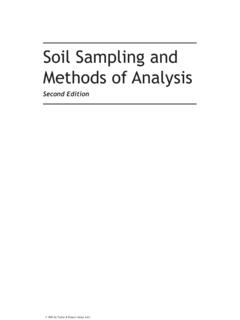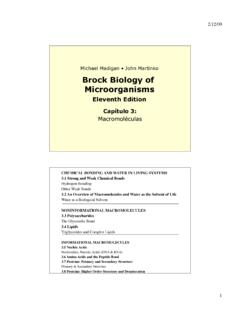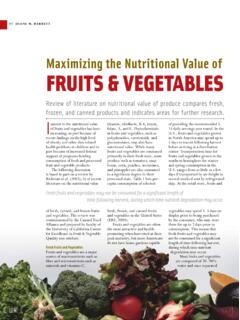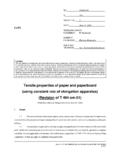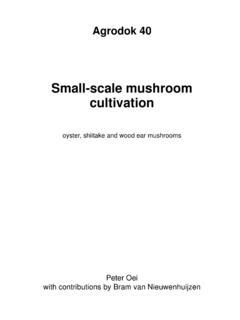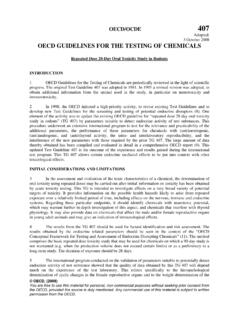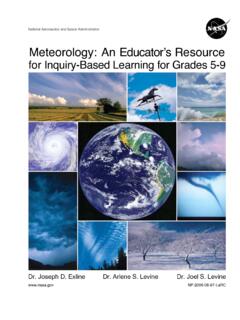Transcription of FAO Irrigation and Drainage Paper
1 FAO Irrigation and Drainage Paper No. 56 Crop Evapotranspiration (guidelines for computing crop water requirements) by Richard G. ALLEN Utah State University Logan, Utah, Luis S. PEREIRA Instituto Superior de Agronomia Lisbon, Portugal Dirk RAES Katholieke Universiteit Leuven Leuven, Belgium Martin SMITH FAO, Water Resources, Development and Management Service Rome, Italy Crop evapotranspiration iii Preface This publication presents an updated procedure for calculating reference and crop evapotranspiration from meteorological data and crop coefficients. The procedure, first presented in the FAO Irrigation and Drainage Paper No. 24 'Crop Water Requirements', is termed the 'Kc ETo' approach, whereby the effect of the climate on crop water requirements is given by the reference evapotranspiration ETo and the effect of the crop by the crop coefficient Kc.
2 Other procedures developed in FAO Irrigation and Drainage Paper No. 24 such as the estimation of dependable and effective rainfall, the calculation of Irrigation requirements and the design of Irrigation schedules are not presented in this publication but will be the subject of later papers in the series. Since the publication of FAO Irrigation and Drainage Paper No. 24 in 1977, advances in research and more accurate assessment of crop water use have revealed the need to update the FAO methodologies for calculating ETo. The FAO Penman method was found to frequently overestimate ETo while the other FAO recommended equations, namely the radiation, the Blaney-Criddle, and the pan evaporation methods, showed variable adherence to the grass reference crop evapotranspiration.
3 In May 1990, FAO organized a consultation of experts and researchers in collaboration with the International Commission for Irrigation and Drainage and with the World Meteorological Organization, to review the FAO methodologies on crop water requirements and to advise on the revision and update of procedures. The panel of experts recommended the adoption of the Penman-Monteith combination method as a new standard for reference evapotranspiration and advised on procedures for calculating the various parameters. The FAO Penman-Monteith method was developed by defining the reference crop as a hypothetical crop with an assumed height of m, with a surface resistance of 70 s m-1 and an albedo of , closely resembling the evaporation from an extensive surface of green grass of uniform height, actively growing and adequately watered.
4 The method overcomes the shortcomings of the previous FAO Penman method and provides values that are more consistent with actual crop water use data worldwide. Furthermore, recommendations have been developed using the FAO Penman-Monteith method with limited climatic data, thereby largely eliminating the need for any other reference evapotranspiration methods and creating a consistent and transparent basis for a globally valid standard for crop water requirement calculations. The FAO Penman-Monteith method uses standard climatic data that can be easily measured or derived from commonly measured data. All calculation procedures have been standardized according to the available weather data and the time scale of computation.
5 The calculation methods, as well as the procedures for estimating missing climatic data, are presented in this publication. In the 'Kc-ETo' approach, differences in the crop canopy and aerodynamic resistance relative to the reference crop are accounted for within the crop coefficient. The Kc coefficient serves as an aggregation of the physical and physiological differences between crops. Two calculation methods ivto derive crop evapotranspiration from ETo are presented. The first approach integrates the relationships between evapotranspiration of the crop and the reference surface into a single Kc coefficient. In the second approach, Kc is split into two factors that separately describe the evaporation (Ke) and transpiration (Kcb) components.
6 The selection of the Kc approach depends on the purpose of the calculation and the time step on which the calculations are to be executed. The final chapters present procedures that can be used to make adjustments to crop coefficients to account for deviations from standard conditions, such as water and salinity stress, low plant density, environmental factors and management practices. Examples demonstrate the various calculation procedures throughout the publication. Most of the computations, namely all those required for the reference evapotranspiration and the single crop coefficient approach, can be performed using a pocket calculator, calculation sheets and the numerous tables given in the publication.
7 The user may also build computer algorithms, either using a spreadsheet or any programming language. These guidelines are intended to provide guidance to project managers, consultants, Irrigation engineers, hydrologists, agronomists, meteorologists and students for the calculation of reference and crop evapotranspiration. They can be used for computing crop water requirements for both irrigated and rainfed agriculture, and for computing water consumption by agricultural and natural vegetation. Crop evapotranspiration vAcknowledgements These guidelines constitute the efforts of eight years of deliberations and consultations by the authors, who together formed the working group to pursue the recommendations of the FAO expert consultation that was held in May 1990 in Rome.
8 The consultation was organized to review the then current FAO guidelines to determine Crop Water Requirements, published in 1977 as FAO Irrigation and Drainage Paper No. 24 (FAO-24) and authored by J. Doorenbos and W. Pruitt. The conceptual framework for the revised methodologies introduced in this publication came forth out of the advice of the group of eminent experts congregated in the 1990 meetings and who have importantly contributed to the development of the further studies conducted in the framework of the publication. Members of the 1990 FAO expert consultation included Dr P. Fleming of Australia, Dr A. Perrier of France, Drs L. Cavazza and L. Tombesi from Italy, Drs R.
9 Feddes and J. Doorenbos of the Netherlands, Dr Pereira of Portugal, Drs Monteith and H. Gunston from the United Kingdom, Drs R. Allen, M. Jensen and Pruitt of USA, Dr D. Rijks from the World Meteorological Organization and various staff of FAO . Many other experts and persons from different organizations and institutes have provided, in varying degrees and at different stages, important advice and contributions. Special acknowledgements for this are due in particular to Prof. Pruitt (retired) of the University of California, Davis and J. Doorenbos of FAO (retired) who set the standard and template for this work in the predecessor FAO-24, and to Prof.
10 Monteith whose unique work set the scientific basis for the ETo review. Prof. Pruitt, despite his emeritus status, has consistently contributed in making essential data available and in advising on critical concepts. Dr James L. Wright of the USDA, Kimberly, Idaho, further contributed in providing data from the precision lysimeter for several crops. Further important contributions or reviews at critical stages of the publication were received from Drs M. Jensen, G. Hargreaves and C. Stockle of USA, Dr B. Itier of France, and various members of technical working groups of the International Commission on Irrigation and Drainage (ICID) and the American Societies of Civil and Agricultural Engneers.
